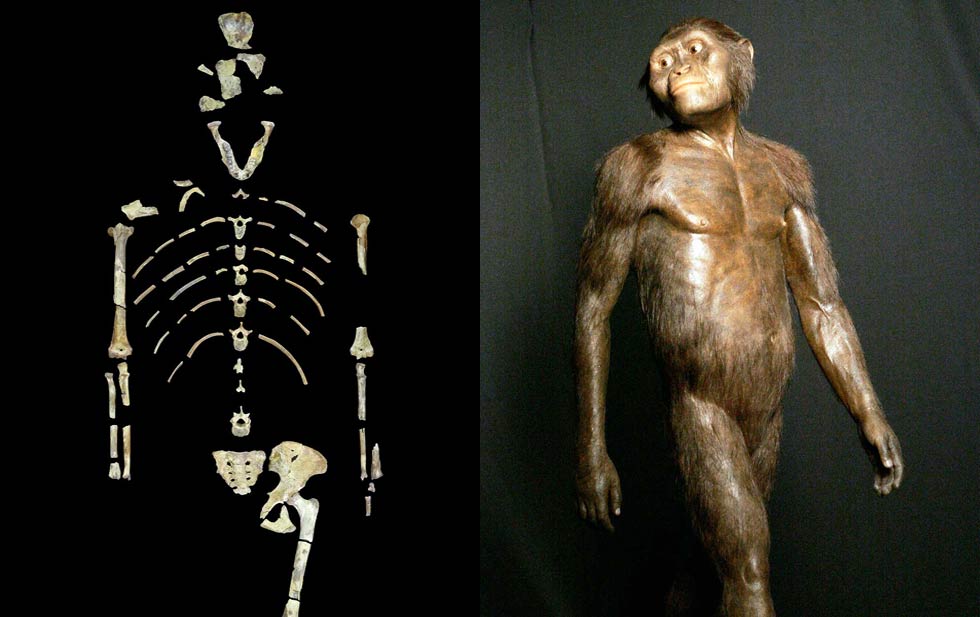Australopithecus human ancestor Lucy could die when falling from a tree

The remains of Australopithecus, known as Lucy, were found in Ethiopia in 1974. Discovered the remains of the alleged human ancestor expedition Donald Johanson. A representative of the species possessed a skull of a small size, like in monkeys, but already knew how to walk straight. The found remains belonged to a female, which archaeologists named Lucy, using the name from the song The Beatles "Lucy in The Sky With Diamonds". This song was constantly listened to by scientists at the excavation site, and the choice of the name was obvious.
Scientists who studied the remains at different times saw a series of bones showing signs of fracture. It was believed that the bones were broken after the death of an individual. But John Kappelman of the University of Texas argues that the cause of death of Australopithecus is a fall from a great height.
Most likely, the fall height was at least 10 meters. And just the fall was the cause of all detected fractures. This is evidenced , in particular, traces on the coccyx, the left humerus and the knee. Scientists studied the skull, arm bones, pelvis and lower limbs. A tomographic examination of the remains was performed. When comparing the results with the data of studying the remains of modern people who died during a fall from a height, it turned out that the injuries are very similar. Fracture, says Kappelman, may indicate that Lucy stretched her forelimbs, trying to soften the blow to the ground.
')
Scientists did not use tomographs to determine the cause of death. Experts wanted to know a little more about the way of life of Australopithecus, and the features of the structure of the skeleton Lucy could give such information. “We wanted to know how she lived, not how she died,” says Richard Ketcham, one of the study participants. "But even Lucy's death helped to know some details of her life, in particular, to learn that she spent time in the trees."
For the first time Kappelman began to study Lucy in 2008. At the same time was carried out and tomographic study, which went higher. After working with a tomograph, scientists received about 35,000 "snapshots" of various parts of the remains of Australopithecus. “Lucy is beautiful. There is only one Lucy in the whole world, and you want to learn as much details as possible, ”says Ketcham. Tomography is good because it is an opportunity to study the skeleton without destroying it. We can find out not only the structure of the bones outside, but also to get acquainted with the internal details. Scientists almost immediately noticed that a fracture of the forearm does not look like fractures of the bones of other remains. The bone broke into several sharp fragments. There are no signs of healing.
“This has already allowed us to say that Australopithecus broke his arm when falling from a height,” says Kappelman. There are other signs of a fall from a height, including a fracture of the humerus, a broken knee and pelvic bones, and trauma to the chest. All these signs together indicate a fall from a height. So says Kappelman and his colleagues. Even the fall rate is calculated - about 55 kilometers per hour.
After that, scientists thought about where Lucy could fall from. Experts came to the conclusion that the tree. As mentioned above, Lucy was small. According to Kappelman, Australopithecus knew and loved to climb trees, despite the fact that they knew how to walk straight. It is likely, says the scientist, that Australopithecus could hide in trees from predators. Perhaps Lucy and her relatives climbed the trees in order to sleep. From the point of view of Kappelman, a number of his colleagues disagree.

Lucy belongs to the Australopithecus Afar type. By the way, this is the first known representative of science of its kind. The height of the specimen found was 105 cm, and the weight was about 27 kilograms. The preservation of the skeleton is about 40% - this is an extraordinary success for anthropologists. Lucy's brain was small, its volume - about 400 cm 3 . The fact that Lucy and her relatives could walk straight, scientists concluded on the structure of the pelvis with the bones of the lower extremities. Judging by the teeth, Lucy died at the age of 25-30 years.
“When we learned about Lucy's injuries, I began to empathize with her through time and distance. Lucy is no longer a bag of bones, but a real person: a small, broken body, lying helplessly under a tree, ”Kappelman says.
Nearly half a century after the discovery of Australopithecus bones in Africa, 3D scans of fragments of the remains of Lucy are posted on the Internet in open access. If desired, these models can be downloaded and printed on a 3D printer, taking up an independent study of the bones.
Source: https://habr.com/ru/post/397059/
All Articles